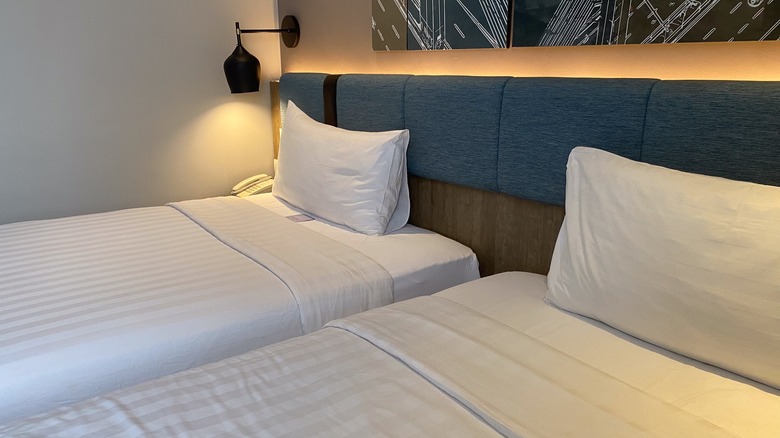The Unusual Way Double Beds Are Set Up In Europe That Leaves American Tourists Baffled
As a tourist, you may be thrown off by a few things when staying in a hotel in Europe. This is especially true if you're used to the bed configurations found in the U.S. Terms such as "twin," "double," and "king" can have a different meaning across the pond, and often, they equate to the same setup: two twins shoved together to make one large bed.
Sometimes, hotel beds put together this way have shared bedding (one top sheet and comforter, for instance), while in other cases, each side has its own bed linens. Either situation can be common in different parts of Europe, but for Americans, the two-beds-as-one design can be baffling. On Reddit, u/EJGryphon wrote, "We got a room [in the Netherlands] with two twin beds pushed together. Separate sheets, separate blankets, etc. Is this normal? And if so, why would a couple from Europe want such an arrangement? The beds keep sliding apart whenever we move around. Quite uncomfortable! No cuddling!"
Similarly, barotia asked on StackExchange, "Recently, in multiple hotels, we paid for a double bed but got two smaller beds near each other instead. [...] Should we complain? Is two twin beds near each other considered a double bed? It feels a little cheap and not correct." While it might feel "not correct" to some, the setup is totally normal in Europe.
Where you might find the twin bed configuration in Europe
Not every traveler staying in Europe from abroad will run into double twin beds in their hotel rooms, but it's a configuration that certainly isn't rare. Hotels in countries across the continent, from the U.K. to Czechia, are known to offer two twin beds in twin rooms, double rooms, king rooms, and other setups. If it's all too confusing, there are a couple of workarounds.
First, booking an international chain hotel might help you avoid European-style bed arrangements in favor of the ones you're likely to find in the U.S. Local boutique hotels across Europe, on the other hand, are more likely to place twin beds together in the rooms. Note, however, that this isn't always the case.
With that last point in mind, another tip is to contact hotels before reserving your room to find out exactly what the beds are like. If you're on a luxurious honeymoon trip and want to avoid having an uncomfortable mattress seam between you and your partner, call or email the property and explain your situation. The same goes for a trip with a friend where you'd prefer two completely separate beds instead of two twins with a single comforter. If the hotel can't accommodate your request, consider looking elsewhere.
The benefits of European double beds
Just like many things in Europe, the double twin bed arrangement can take some getting used to. But once you do, you might just discover its practical benefits. One of the biggest draws of the double twin bed, particularly if the hotel gives you two sets of bedding, is that you can separate the beds if you'd like (though make sure you have enough space between the bedside tables or any other furniture before moving the beds apart). This can be a convenient option for platonic friends who'd prefer some space.
You might also sleep better when given two twin beds instead of one large bed. If you're given separate bedding, you can each sleep on your own side without fighting for the blankets. And even if you do share a comforter, having two separate mattresses might mean you're less likely to wake the other when moving in the middle of the night.
Of course, the configuration also benefits hotels, too, and not just the guests. Placing two twin beds in one room gives the hotel greater flexibility and makes it easier to fill different types of rooms. Plus, some properties, especially older buildings with narrow doors and steep staircases, aren't equipped to fit large king-sized beds. Using twin beds in place of larger mattresses is a simple solution that most people — or most local European visitors, at least — wouldn't mind.


